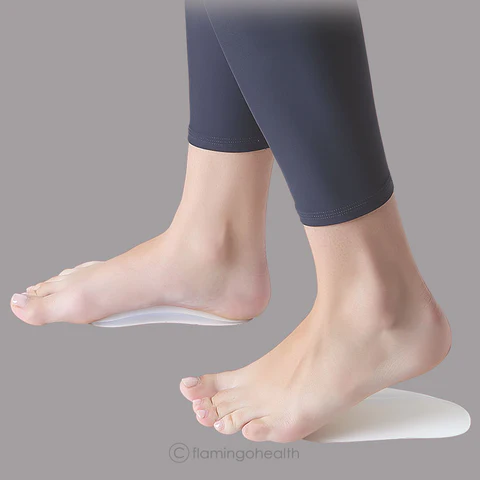Introduction: Understanding Arch Support
Our feet are remarkable structures that carry us through life’s journeys, yet they often don’t receive the attention and care they truly deserve. In the hustle and bustle of modern life, we tend to overlook the importance of foot health. This oversight can have a significant impact on our overall well-being. One crucial element of foot health is understanding the significance of arch support.
Arch support isn’t just a buzzword in the world of podiatry; it’s a fundamental concept that can make a world of difference in how we move, stand, and live. In this comprehensive article, we will delve deep into the world of arch support. We’ll explore what arches are, why they matter, and how you can find the right balance to support them effectively.
As you read on, you’ll discover the intricate anatomy of your feet, the role that arches play in maintaining stability and balance, and practical steps to ensure your feet are well-supported. By the end of this article, you’ll have a profound understanding of how arch support can enhance your daily life and promote lifelong foot health.
So, let’s take the first step towards better foot care and explore the world of arch support together.
The Anatomy of the Foot Arch
To truly appreciate the importance of arch support, we must first delve into the fascinating world of foot anatomy. Our feet are incredibly intricate structures composed of 26 bones, 33 joints, and over 100 muscles, tendons, and ligaments. At the heart of this complexity lies the arch.
The Three Arches of the Foot
Our feet possess three distinct arches, each playing a unique role in supporting our body weight and providing stability:
1. Medial Longitudinal Arch (Inner Arch)
The medial longitudinal arch runs along the inner side of the foot, from the heel to the ball of the foot. This arch is the highest and most prominent of the three and is responsible for absorbing the shock generated with each step we take. It also helps in weight distribution, ensuring that forces are evenly spread across the foot.
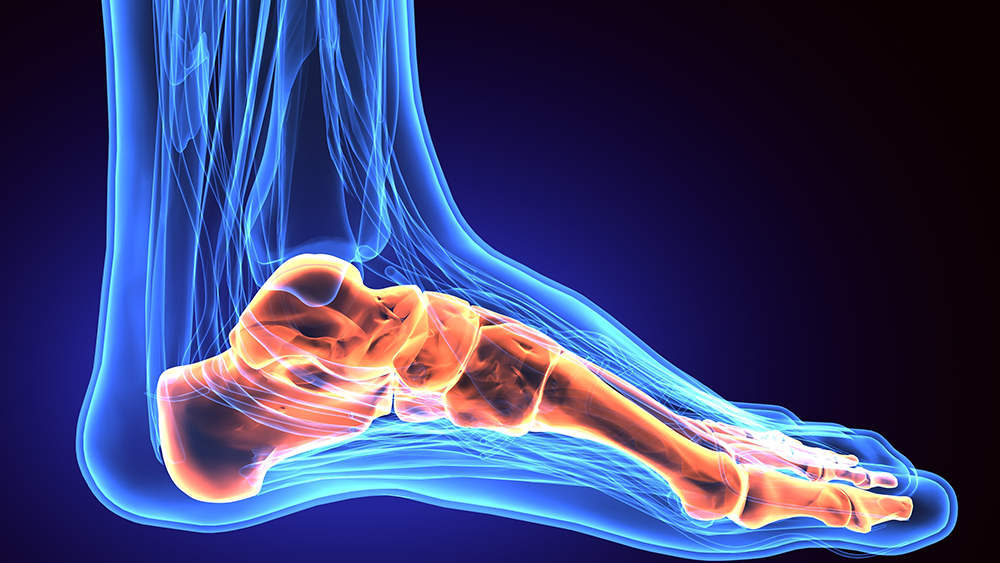
2. Lateral Longitudinal Arch (Outer Arch)
The lateral longitudinal arch runs along the outer edge of the foot, parallel to the medial arch. It provides additional stability and helps us maintain balance, especially when we shift our weight to the outer part of the foot.
3. Transverse Arch (Midfoot Arch)
The transverse arch stretches across the midfoot, perpendicular to the longitudinal arches. This arch acts as a natural spring, allowing our feet to adapt to uneven terrain and absorb shocks efficiently.
The Arch’s Composition
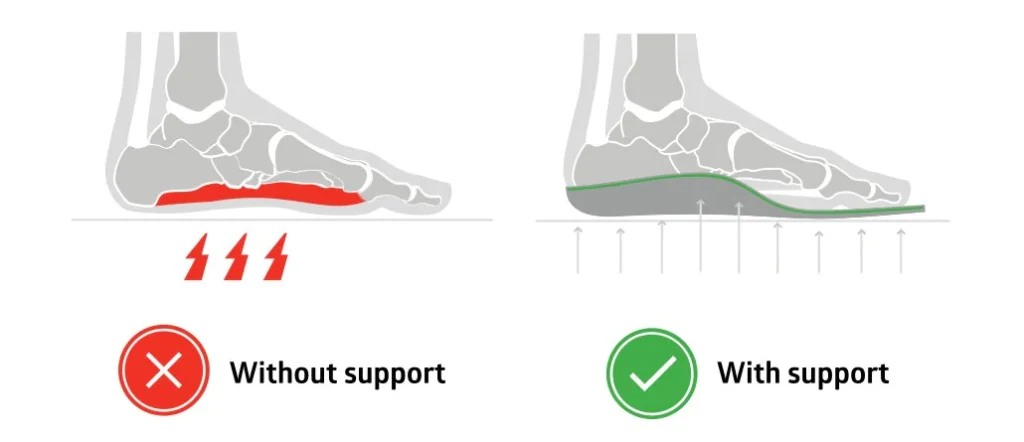
The arches are not just empty spaces under our feet; they are meticulously structured using bones, tendons, and ligaments:
- Bones: The bones of the arches include the tarsal bones, metatarsal bones, and phalanges. These bones work together to form a supportive framework for the arches.
- Tendons: Tendons, such as the plantar fascia, connect muscles to bones and help maintain the arch’s shape and function.
- Ligaments: Ligaments are strong, fibrous tissues that connect bone to bone. In the foot, ligaments reinforce the arches, ensuring they remain stable during weight-bearing activities.
Understanding this intricate architecture is crucial because it underscores the significance of arch support. Properly supporting the arches means preserving their natural shape and function, which, in turn, contributes to overall foot health and comfort.
As we move forward in our exploration of arch support, you’ll discover how essential it is to maintain the integrity of these arches to ensure balance and stability in every step you take.
The Significance of Arch Support
Arch support may seem like a minor consideration in the grand scheme of our busy lives, but its importance cannot be overstated. It is a fundamental aspect of foot health that extends its influence far beyond our feet. Let’s dive into the significance of arch support and why it matters:
1. Alignment Matters
Proper arch support is your first line of defense against poor foot alignment. When your arches are well-supported, they maintain their natural shape and prevent overpronation (excessive inward rolling of the foot) or supination (excessive outward rolling). Maintaining the correct alignment of your feet is essential for overall posture and balance.
2. Shock Absorption
Every step you take subjects your feet to significant forces and impacts. Without adequate arch support, your feet may not absorb shock efficiently. Over time, this can lead to discomfort, fatigue, and even injuries. Arch support acts as a cushion, absorbing shock and reducing the stress on your joints.
3. Even Weight Distribution
Your body weight is distributed across your feet as you stand, walk, or run. Improper arch support can disrupt this distribution, causing certain areas of your feet to bear more weight than they should. This imbalance can lead to pain, calluses, and even structural issues. Proper arch support ensures an even distribution of weight, reducing the risk of these problems.
4. Enhanced Stability
Arch support enhances the stability of your feet and ankles. When your arches are well-supported, your feet are less likely to roll inward or outward, reducing the risk of ankle sprains and other injuries. This stability extends upward, promoting better posture and reducing strain on your knees, hips, and lower back.
5. Improved Athletic Performance
For athletes and active individuals, arch support is a game-changer. It not only reduces the risk of injuries but also enhances performance. With proper arch support, you can run, jump, and move with greater confidence and efficiency, unlocking your full potential.
6. Long-Term Foot Health
Perhaps the most significant significance of arch support is its role in long-term foot health. By taking care of your arches today, you can prevent a host of problems in the future, such as plantar fasciitis, bunions, and chronic foot pain. It’s an investment in your well-being that pays dividends over a lifetime.
In essence, arch support is not just a matter of comfort; it’s a cornerstone of overall health and vitality. As we continue to explore the world of arch support, we’ll guide you through the process of finding the right support for your unique needs, ensuring that you can step up to life’s challenges with confidence and comfort.
Choosing the Right Footwear
Now that we understand the significance of arch support, it’s time to explore how your choice of footwear plays a crucial role in maintaining proper support for your arches. Here are some essential considerations when selecting the right footwear:
1. Arch Support Built-In
The most straightforward way to ensure arch support is to choose shoes that are designed with built-in support. Look for shoe brands that prioritize foot health and offer models specifically crafted to provide excellent arch support. These shoes often feature contoured insoles and reinforced arch areas.
2. Custom Orthotic Inserts
If you have a specific need for arch support due to unique foot characteristics or conditions, consider custom orthotic inserts. These inserts are tailor-made to fit your feet and provide precisely the support your arches require. A podiatrist can assess your feet and recommend custom orthotics if necessary.
3. Proper Fit
No matter how good the arch support is, ill-fitting shoes can negate its benefits. Ensure that your footwear fits correctly. Your toes should have enough room to wiggle, and there should be no pressure points that could cause discomfort or blisters. Shoe size can vary between brands, so always try shoes on before buying.
4. Material Matters
The material of your shoes matters when it comes to comfort and support. Opt for breathable materials like leather or mesh for better ventilation, especially if you’ll be wearing them for extended periods. Breathable materials can help prevent moisture buildup and odor.
5. Consider Activity
The type of footwear you need depends on your activities. Athletic shoes with arch support are vital for sports and physical activities, while work shoes or dress shoes should also offer appropriate arch support. Different activities may require different levels of support, so choose accordingly.
6. Regular Replacement
Even the best footwear wears out over time. Check your shoes regularly for signs of wear and tear. If the insoles have become flattened or the outsoles are worn unevenly, it’s time to replace them. Continuing to wear worn-out shoes can compromise your arch support.
7. Consult a Specialist
If you have specific foot conditions or concerns, it’s wise to consult a podiatrist or orthopedic specialist. They can provide expert advice on the best footwear options for your unique situation.
Remember that your choice of footwear can significantly impact your foot health and overall well-being. By selecting shoes that prioritize arch support and comfort, you’re taking a proactive step towards maintaining the health of your arches and ensuring a more comfortable and pain-free life.
In the following sections, we’ll delve deeper into additional ways to maintain arch support and keep your feet in excellent condition.
DIY Methods for Improving Arch Support
While investing in proper footwear and custom orthotics is essential for maintaining arch support, there are also several do-it-yourself (DIY) methods that can complement these efforts. These methods can help you strengthen your arches and alleviate discomfort. Let’s explore some DIY strategies:
1. Foot-Strengthening Exercises
a. Toe Tapping: Sit comfortably and tap your toes on the floor for about 30 seconds. This exercise helps improve blood circulation in your feet and strengthens the muscles supporting your arches.
b. Toe Flexing: Alternate between pointing your toes and flexing them upwards. Repeat this exercise for about 30 seconds. It stretches and strengthens the muscles and tendons in your feet.
c. Towel Scrunches: Place a small towel on the floor and scrunch it up with your toes. Try to make the towel as small as possible. This exercise targets the muscles of the arch and helps improve their strength.
2. Stretching Routine
a. Calf Stretches: Tight calf muscles can affect arch support. Perform calf stretches regularly to keep these muscles flexible. Stand facing a wall, place one foot behind you, and press your heel into the ground while keeping your back leg straight. Hold for 30 seconds and repeat on both sides.
b. Plantar Fascia Stretch: Sit down and cross one ankle over the opposite knee. Gently pull your toes back towards your shin. This stretch targets the plantar fascia, which plays a crucial role in arch support.
3. Massage and Rolling
a. Foot Massage: Give yourself a foot massage using your hands or a tennis ball. Focus on the arch area to relieve tension and improve blood flow.
b. Rolling: Roll a tennis ball or a frozen water bottle under your foot, applying gentle pressure. This self-massage technique can alleviate discomfort and improve the flexibility of your arch.
4. Proper Footwear at Home
Don’t forget to prioritize arch support even when you’re at home. Consider wearing supportive slippers or shoes with arch support inserts to provide ongoing care for your feet.
5. Maintain a Healthy Weight
Excess body weight can put additional strain on your arches. Maintaining a healthy weight through a balanced diet and regular exercise can reduce the burden on your feet and improve arch support.
6. Stay Hydrated
Dehydration can lead to muscle cramps and stiffness, affecting your arches’ flexibility. Ensure you’re adequately hydrated throughout the day to keep your muscles and tendons functioning optimally.
7. Listen to Your Body
Pay attention to any signs of discomfort or pain in your feet. If you experience persistent arch pain, consult a healthcare professional or a podiatrist for expert guidance and recommendations.
By incorporating these DIY methods into your daily routine, you can actively contribute to better arch support and overall foot health. Remember that consistency is key, and these practices can complement the support provided by your footwear and orthotic inserts.
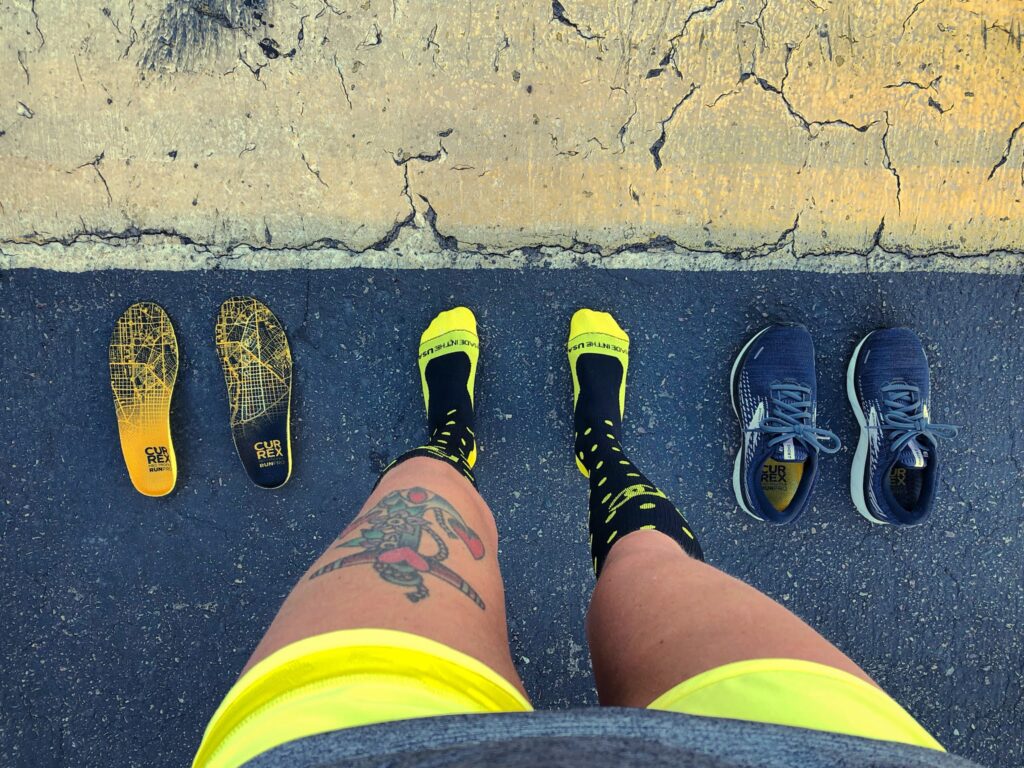
The Role of Arch Support in Different Activities
Arch support isn’t a one-size-fits-all concept; its significance varies depending on the activities you engage in. Here, we’ll explore how arch support plays a vital role in different types of activities and why it’s crucial to choose the right support for each:
1. Daily Activities
Whether you’re walking to work, running errands, or simply going about your daily routine, proper arch support is essential. It helps maintain good posture, prevents foot fatigue, and reduces the risk of overpronation or supination during prolonged periods of standing or walking.
2. Athletic Pursuits
Engaging in sports and physical activities places unique demands on your feet. Sports like running, basketball, and tennis involve repetitive impact and lateral movements. Arch support in athletic footwear helps absorb shock, maintain stability, and prevent injuries such as shin splints and stress fractures.
3. Hiking and Outdoor Adventures
Exploring the great outdoors often means traversing uneven terrain. Hiking boots and shoes with robust arch support provide the stability needed to navigate rocky paths and steep inclines. This support reduces the risk of ankle sprains and foot fatigue, allowing you to enjoy your adventures comfortably.
4. Workplace and Occupational Activities
Jobs that require prolonged standing or walking, such as nursing, retail, or manufacturing, can take a toll on your feet. Proper arch support in work shoes can alleviate discomfort and reduce the risk of conditions like plantar fasciitis and bunions.
5. Formal Occasions
Even on special occasions that call for formal footwear, arch support should not be overlooked. Look for dress shoes with cushioned insoles and adequate arch support to ensure that you can enjoy the event without foot discomfort.
6. Dance and Performance Arts
Dancers, actors, and performers put their feet through rigorous activities that demand precise control and balance. Dance shoes and performance footwear often have specialized arch support to help artists maintain stability during intricate movements.
7. Recovery and Rehabilitation
In some cases, individuals may require arch support as part of their recovery or rehabilitation process. Arch support aids in alleviating pain associated with various foot conditions, such as plantar fasciitis, flat feet, and Achilles tendonitis.
8. Everyday Comfort
Beyond specific activities, arch support contributes to everyday comfort. It can help reduce foot fatigue, alleviate lower back pain, and enhance overall well-being, making daily life more enjoyable.
The key takeaway is that arch support is not a one-time consideration but an integral aspect of your overall health and comfort, no matter what activities you engage in. Tailoring your arch support to the specific demands of each activity ensures that you can perform at your best while minimizing the risk of discomfort and injuries.
In the following section, we’ll explore how to maintain and care for your arch support to ensure its longevity and effectiveness across various activities.
Common Misconceptions About Arch Support
Arch support is a topic often surrounded by misconceptions and myths. To make informed decisions about your foot health, it’s essential to debunk these common misunderstandings:
1. One-Size-Fits-All Arch Support
Misconception: Many people believe that a single type of arch support will work for everyone, regardless of their foot shape or needs.
Reality: Arch support is not one-size-fits-all. Different individuals have different foot arch shapes and levels of flexibility. What works for one person may not work for another. Customized arch support, tailored to your unique foot characteristics, is often the most effective approach.
2. Arch Support Leads to Weaker Arches
Misconception: Some individuals worry that relying on arch support will make their arches weaker over time, as they might become dependent on external support.
Reality: Arch support, when used appropriately, does not weaken your arches. Instead, it helps maintain the proper alignment and function of your arches. In cases where arches are already weakened, arch support can be beneficial in providing the necessary stability and reducing strain.
3. Arch Support Is Only for People with Foot Problems
Misconception: Some think that arch support is only necessary for individuals with existing foot conditions or pain.
Reality: Arch support is not solely for those with foot problems. It can benefit everyone by enhancing comfort, stability, and overall foot health. Preventative arch support can help reduce the risk of future issues.
4. All Shoes Provide Adequate Arch Support
Misconception: People assume that any pair of shoes will provide sufficient arch support.
Reality: Unfortunately, not all shoes are created equal when it comes to arch support. Many fashionable or poorly designed shoes lack proper support, which can lead to discomfort and foot problems over time. Choosing footwear with built-in arch support is crucial for maintaining foot health.
5. Arch Support Is Uncomfortable
Misconception: Some believe that arch support feels uncomfortable or restrictive.
Reality: Modern arch support technology focuses on providing both support and comfort. With the right footwear and inserts, you can enjoy the benefits of arch support without sacrificing comfort. It may take a brief adjustment period for your feet to get used to proper support.
6. Arch Support Is Only for Older Individuals
Misconception: It’s a common belief that arch support is primarily needed as people age and their feet naturally weaken.
Reality: Arch support is beneficial for individuals of all ages. It’s not solely related to age but rather to foot structure, activity levels, and individual needs. Younger individuals who engage in sports and physical activities can also benefit significantly from proper arch support.
7. Arch Support Is Expensive and Inaccessible
Misconception: Many assume that good arch support options are prohibitively expensive or hard to find.
Reality: While there are premium arch support products available, there are also affordable options that provide excellent support. Furthermore, with the growth of online shopping and specialty stores, finding suitable arch support has become more accessible than ever.
By dispelling these common misconceptions, you can make more informed decisions about your arch support needs and prioritize foot health in your daily life. Proper arch support is a valuable investment in your overall well-being, ensuring that you can step up to life’s challenges with comfort and confidence.
In the next section, we’ll discuss practical steps for maintaining and caring for your arch support to maximize its effectiveness.
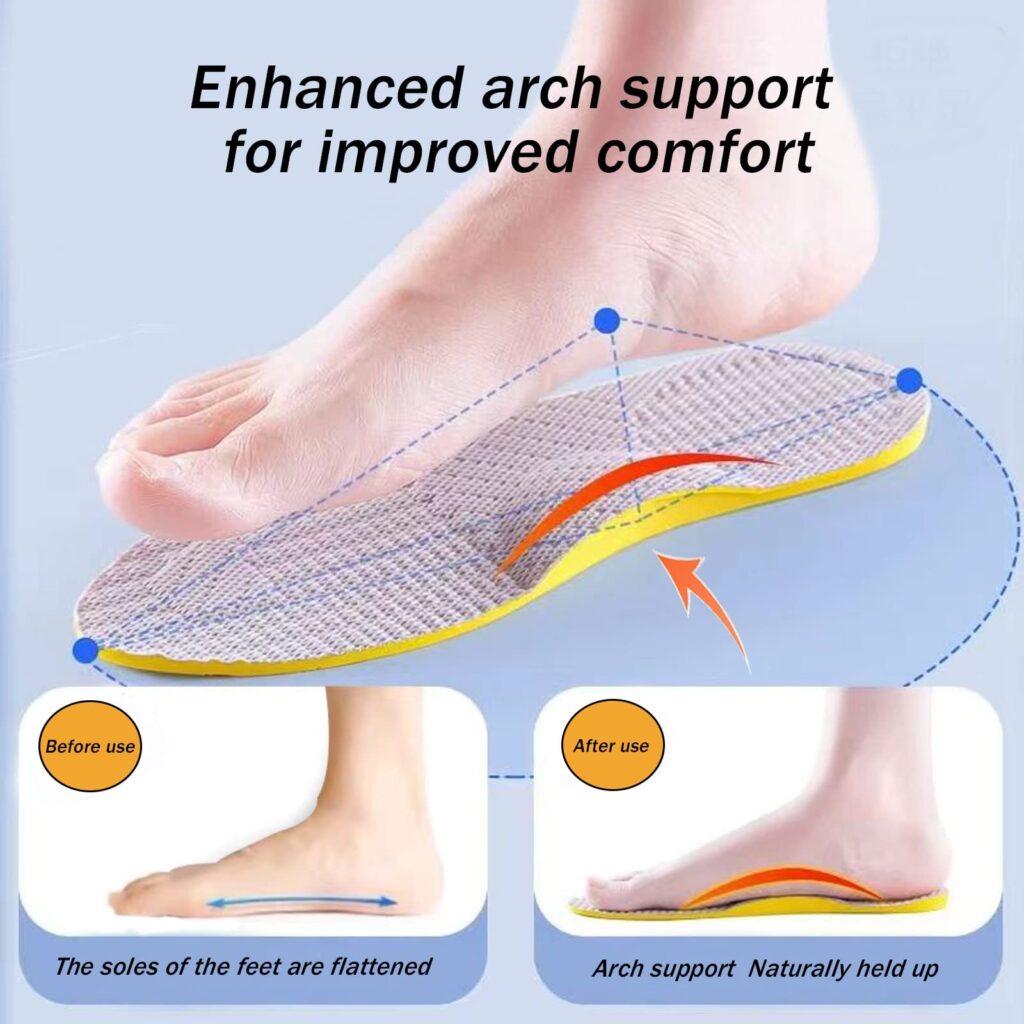
Maintaining Healthy Arches
Now that we’ve explored the significance of arch support and debunked common misconceptions, it’s time to delve into how you can actively maintain the health of your arches. By following these practical steps, you can ensure that your arch support remains effective and your feet stay in optimal condition:
1. Regular Foot Exercises
Incorporate foot-strengthening exercises into your daily routine. This can include toe tapping, toe flexing, and towel scrunches, as mentioned earlier. These exercises help keep the muscles and tendons supporting your arches strong and flexible.
2. Stretching Routines
Regularly stretch your calf muscles and the plantar fascia to prevent tightness that could affect your arches. Stretching can improve flexibility and relieve tension in the arch area.
3. Massage and Rolling
Give your feet a massage or roll a tennis ball under them regularly. Massaging the arch area can alleviate tension and improve blood circulation. Rolling a ball or frozen water bottle under your feet helps relax the arch muscles.
4. Maintain a Healthy Weight
Excess body weight can strain your arches and lead to discomfort. Maintaining a healthy weight through a balanced diet and regular exercise can reduce this strain.
5. Stay Hydrated
Dehydration can cause muscle cramps and stiffness in your feet. Ensure you’re adequately hydrated throughout the day to keep the muscles and tendons in your feet functioning optimally.
6. Wear Supportive Footwear
Choose shoes with adequate arch support for various activities, such as sports, work, and casual outings. Make sure your footwear fits properly and replace worn-out shoes promptly.
7. Custom Orthotic Inserts
Consider custom orthotic inserts if you have specific arch support needs or foot conditions. Consult a podiatrist for personalized recommendations and orthotic fittings.
8. Listen to Your Body
Pay attention to any signs of discomfort, pain, or changes in your arches. If you experience persistent arch pain or discomfort, seek professional advice from a podiatrist or healthcare specialist.
9. Regular Maintenance
Inspect your arch support products, such as orthotic inserts, for signs of wear and tear. Replace them as needed to ensure they continue to provide effective support.
10. Professional Assessment
Schedule regular check-ups with a podiatrist or foot specialist. They can assess the health of your arches, recommend appropriate support, and address any concerns promptly.
By incorporating these practices into your daily life, you actively contribute to the health and longevity of your arches. Remember that consistency is key, and maintaining healthy arches is an ongoing process. With proper care and support, you can continue to step up with confidence and comfort in all your activities.
In the final section of this article, we’ll conclude our exploration of arch support and provide answers to some common questions related to this crucial aspect of foot health.
Arch Support for Specific Conditions
Understanding how arch support caters to specific foot conditions, such as flat feet, high arches, or issues like plantar fasciitis, is crucial for personalized foot care.
The Evolution of Arch Support in Footwear
The journey of arch support in footwear has been an evolving one. From historical perspectives to the latest technological innovations, the aim has always been to enhance comfort and support for the wearer.
Conclusion
In the pursuit of balanced, healthy feet, embracing proper arch support emerges as a fundamental step. From choosing the right footwear to engaging in exercises and dispelling misconceptions, every effort contributes to maintaining strong and supported arches, ensuring overall well-being.
FAQs
- Is arch support necessary for everyone? Arch support is beneficial for most people, especially those with foot-related issues or those who engage in activities that strain the feet.
- Can I improve my arches without specialized footwear? Yes, exercises and orthotic supports can help strengthen the arches, but specialized footwear often provides additional benefits.
- Do high arches require different types of support compared to flat feet? Yes, high arches and flat feet have different support needs, and it’s essential to address them accordingly.
- Can inadequate arch support cause knee or back pain? Yes, misalignment due to poor arch support can lead to pain in various areas, including the knees and back.
- How often should I replace footwear with arch support? It’s recommended to replace footwear regularly, especially if you notice a decline in support or comfort.
